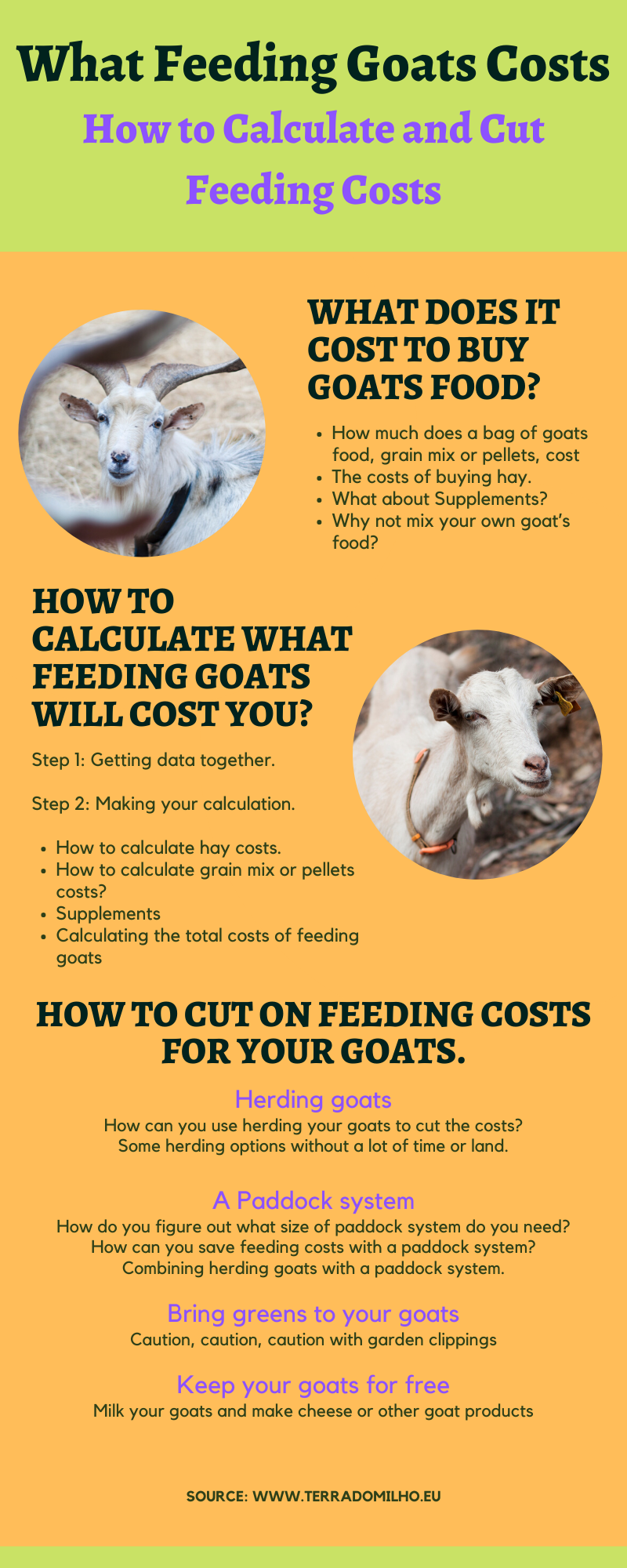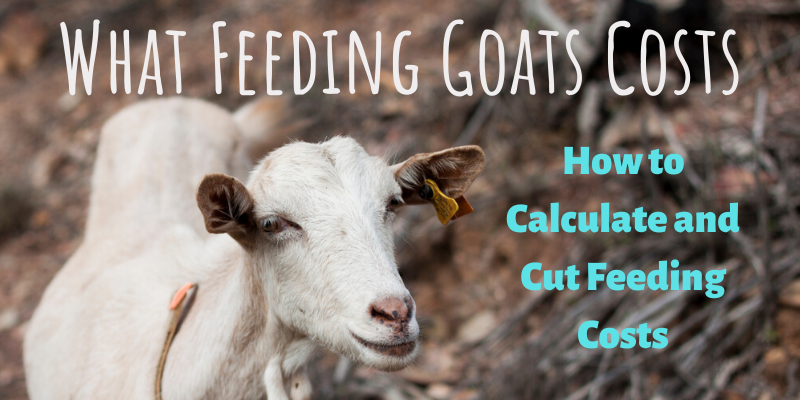
Do you want to buy goats for your homestead or small scale farm? Do you wonder if it would be worth doing so and what it would cost you to feed goats?
Well, here is how you know what feeding your goats would cost you.
What is in this blog?
Sure, you will have to make some investments when you start keeping goats, like in making a goat house or putting up fencing but feeding goats will be the lasting expense. That is why it is important to look into it well.
And guess what? There are even some possibilities to cut some of the costs, we will look into that as well.
Let’s go and calculate how much feeding your goats will cost you first. After that I will show you some options how you can cut the costs.
You might guess: it depends on where you are in the world. But no worries, we will get that clear for you.
There are two types of food that you, very likely, will buy for your goats:
In the Netherlands A bag of 25 kg (55 lb) organic goat food costs about 18€ (20 USD on 11/10/19).
In Portugal we pay 10€ (11 USD on 11/10/19) for a 30 kg (66 lb) non organic pellets. Organic pellets are not available and have to be imported from Spain.
In the USA it depends where you are and where you buy. I asked around in one of the Facebook groups I am a member of. Here is an indication of the moment (11/10/19):
The amounts of grain mix and pellets that you need to feed your goats are usually mentioned on the package.
The costs that are given here are just an indication so you get a briefe idea. If you make a proper calculation it will be better to check the prices in your neighbourhood, as we will see further down.
It is very hard to give a standard price for hay. It does not only vary per country but very much per location as well. A neighbour might be selling hay for a good price to you, or the hay has to come from afar to a much higher cost.
Whether you have to give your goats free available hay the whole year round, no matter what, is part of an ongoing dispute amongst goat keepers and even amongst researchers.
We follow the recommendation from our vet to give our goats hay all year round. This is why: When goats eat something wrong or when there are sudden changes in their diet hay can save the goats.
Goats also need long fibers for their digestive system and hay will provide this for them.
Grain mixes and pellets do not always cover all the goats needs. Goats also need minerals. A so called salt block or “licking brick” can be hung in their free range zone so they can freely lick the minerals that they need.
Can I be totally honest with you? Mixing your own goat feed will take you into complicated tables and calculations.
Collecting and mixing the different ingredients can also take space and time. In the end the product that you will feed your goats might not even be cheaper.
So as a starter I would not recommend going there. Start simple and than when you have your goats system going, go look deeper into feeding details if you like. Than you could start mixing goat food yourself.
If you can not resist to look into it: I put a link in the resources at the end of the blog.
Now you know that prices can vary, depending on where you live, let’s see how to make a calculation of what your goats would cost you in your area.
Now you have chosen what you want to buy and where you want to buy it, you can calculate what your goats will cost.
I will guide you through the calculation and give you an example of what feeding goats on our farm costs based on our own situation.
Are you ready? Let’s go for the next step.
To know how much hay you have to buy you can use this simple calculator (click on the link): Livestock Winter Hay Needs – Hay Calculator
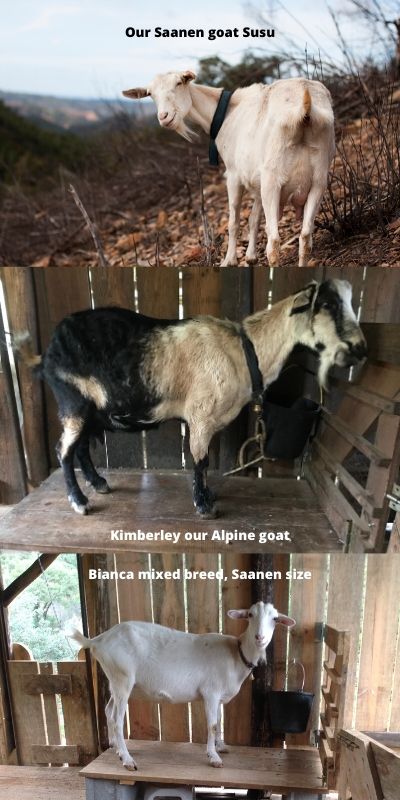
The amount of hay in the calculator depends on the weight of your goat. Since you might not know what a goat weighs I will give you some figures on goats weights so you can fill in the calculator.
An adult Saanen type dairy goat weighs around 95 kg (209 lbs).
A goat of a smaller breed like an Alpine goats weighs about 60 kg (135 lbs).
When you already have a goat here is an easy way to find out what it weighs without using a scale (click on link): How to Calculate Sheep or Goat Weight
Through the calculator you can find out how many hay bales you need. You will need to fill in the weight of the hay bales that you can buy.
After that you can multiply the number of hay bales with the price per hay bale that you have found and written down in your notes.
For example: On our farm we need to feed our 5 goats on hay for two month during the dry summer. During the winter month there is a lot of pasture available so the goats will hardly eat the hay, but we do give them free available hay.
From filling in the calculator we learn that we will need 35 bales of hay for the dry month. A hay bale costs us 3.50€, so in a year we will spend 3.50€ x 35 = 122.50€ (136,51€ on 12/17/2019).
In our case we also give the goats freely available hay during the green winter month which would add another 10 bales. This costs us an extra 35€.
Which brings our total spending on hay to 157.50€ (174.51 USD on 12/21/2019)
Since our farm is located in Portugal, a bag of 30 kg (66 lbs) of pellet feed for goats costs me 10€ (11 USD).
According to the information on the bag my goats needs 600 grams (1.3 lbs) per day when in milk. This means one goat will cost me 0.20€ a day during the milking times.
The goat will produce milk during 10 month a year, from halve way of February to halve way of December, which comes down to 304 days. So feeding pellets to one goat during the milking period will cost me: 0.20€ x 304 days = 60.80€
During the milking break one goat gets halve a portion of pellets per day, 300 grams (0.65 lbs). This will cost 0.10€ a day.
The milking break takes 2 month which is 60 days. So during the milking break the feeding of one goat will cost me 0.10€ x 60 days = 6€.
So for the whole year I will spend 60.80€ + 6€ =66.80€ per goat.
We have got 5 goats so in total I will spend 66.80€ x 5 = 334€ a year on buying pellets.
As a supplement on the feed and the hay I use a a so called salt block licking brick it is cheap and easy and the goats can serve themselves. They like it a lot.
I buy a salt block about one time a year, it costs about 10€.
To feed my goats the year round I will spend:
Hay, 157.50€
Pellets, 334€
Licking brick, 10€
So the total costs of feeding my 5 goats will be: 501.50€ a year, which equals 41.79€ a month.
Keep in mind that these are only the feeding costs, it does not include other costs for keeping goats. Other costs at my location are connected to the housing, fencing, some small stuff like buckets and laces and the vet.
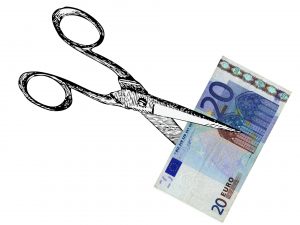
Now you know what keeping goats will cost you, let’s look into how you can cut on the feeding costs.
Here we go!
This is the oldest way of keeping goats. And it costs hardly anything to feed them. The goats will collect their own food while taken out for a walk.
Back in the days in our area a group of farmers would hire in a shepherd to herd their goats. Each farmer would buy some goats which would then be put together in one herd for the shepherd . The costs for the shepherd would be divided amongst the farmers. In return the farmers would get milk and meat to sustain their families. This way the costs for keeping goats were kept very low.
Herding goats for the whole day would take a lot of time and most of us don’t have that amount of time.
Another thing that is needed is: free range wilderness, either your own or your neighbours. You can not walk your goats through an area with a lot of gardens. But even in such an area there can be options.
Although taking your goats out all day to vast areas of land surrounding you, might not be an option, you could still save feeding costs by taking them out for one or two hours a day.
Maybe you have a son or daughter that loves to take them out after school together with some friends. Or maybe someone else in the family who wants to save some money on the gym and take the goats for a good walk every day.
Land wise: There might be a paddock or piece of wild land fenced in down the road where you could take the goats. Of course you will have to check first with the owner if it’s alright to take your goats there.
Just another idea….During the winter month, that is when the rain falls in our climate, we herd our goats through our orchard. Most trees have no leaves. The goats are not interested in the leafless trees but they will eat all the upcoming weeds.
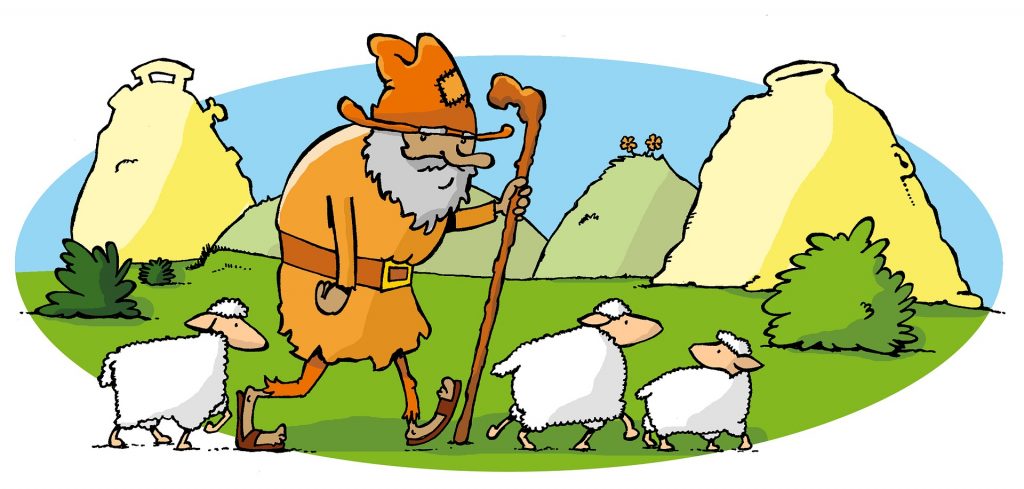
When you have a piece of land surrounding you, you can fence it in and divide it into sub areas. Each area can be fenced in so you can rotate the goats through the areas.
The areas do not need to be grass fields. Goats love to eat vines, shrubs and trees and it is very healthy for them too.
It might seem a bit a sidetrack to talk about the size of a paddock system here, but in order to know whether having your goats in your paddock system is an option for you, I will shortly go there.
The size of the paddocks that you need will depend on things like number of goats, soil fertility and annual rainfall.
Let me show you how extreme the difference can be:
Conclusion: when you are living in a place with fertile soils and substantial rainfall, you can easily run a paddock system for your goats with less than a hectares. In other areas you will have to slowly figure out how much of an area you need. Either by trial and error or by asking people around you with goats.
When you give your goats free available hay, like we do, you immediately notice that they use less hay when their free range area is getting green during the winter rains. The goats eat far less hay. This way we will need to buy les hay.
The other thing is that they stop finishing their daily portions of grain mix that I give them. I can almost cut the amount down by halve.
Mind you, some goats will gobble their feed down anyway regardless whether they need it or not. In which case you can manage their food intake by a tool that is called body condition scoring. Body condition scoring is a good tool to manage how much you have to feed your goats. Check this link if you want to know more about it: Body Condition Scoring For Dairy Goats, Made Easy.
Because of our goats free range area getting green, and because of two hours of herding we do with our goats, we can cut down our costs on hay and grain mix substantially.
During spring we clear our orchard terraces. Out comes: a lot of pruned branches, cut back shrubs and cut grass with a lot of herbs in it. The goats love it all.
Bringing greens to your goats also provides them with food, so it will save you buying food. At ours it cuts the costs of buying hay.
When you are bringing your goats greens from your garden, there is some caution you have to take with using garden clippings:
Yes, it’s true! By milking your goats and making cheese you can have your goats and home produced milk and cheese for free.
How? By producing your own milk and cheese for your household you can save money on buying it. When you sell part of the milk and cheese you can get some income to cover all the costs that you have for your goats. This way you can keep your goats for free and have fresh milk and cheese as a bonus!
Here are some more ideas:
By using and selling goats products you can either save on your household budget or earn some money to cover the costs on keeping your goats.
If you want to sell goat products check the local regulations on selling animal products.
Body Condition Scoring For Dairy Goats, Made Easy This blog will explain how you can manage the amount you feed your goats by Body Condition Scoring.
Feeding Goats, Some Things You Didn’t Know This blog will tell you about what goats eat and how their digestive system works.
What Not To Feed Goats To Avoid Accidents Here you will find information about what not to feed your goats and how you can find out which plants are poisonous for your goats.
Livestock Winter Hay Needs – Hay Calculator An easy calculator to calculate the quantity of hay you need per year. You can also use it when you need hay over the summer. By the way, we do not sell these company’s tools, it is just a very practical calculator that we use.
How to Calculate Sheep or Goat Weight This shows you how to calculate the weight of a goat without having to use scales. A practical tool that is commonly used, described on the site of Washington state University.
The Langston Interactive Nutrient Calculator This is the most simplified and best calculator I could find for you. It’s from the American Institute for goat research at Langston University in Oklahoma.
Useful Facebook groups were you can meet other goat keepers, you will have to become a member: Goats and Goat Lovers and Homesteading and Sustainability.
